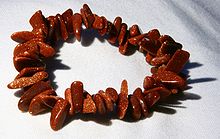Gold flow
Gold flow , also known as aventurine glass or gold stone, is a synthetic glass that is often used as a jewelry material. It is not, as is often stated in sales, a natural mineral.
Gold flux is a glass made with copper or copper (I) oxide in a reducing flame . In a normal oxidative environment the copper would react with the silicon of the glass and form a blue-green glass, but in the reducing environment the copper remains isolated as atoms and forms small crystalline clusters . The finished product can be polished, sanded, or poured into molds, and is often used in fashion jewelry and esoteric artifacts similar to a gem stone . It is often used as a substitute for natural aventurine ( aventurine quartz and aventurine feldspar ).
The most common form has a reddish-brown appearance, with the color coming from tiny, embedded copper particles. The glass, which is colorless in the flow of gold, consists mainly of quartz, to which soda , lead or boron are added to increase hardness and temperature resistance .
Variants with colored glass are produced under the name of blue river with inclusions of manganese and cobalt and green river with chromium and purple river with manganese.
history
The manufacturing process for Gold River was in Venice of the 17th century discovered by the family Miotto, of the Doge of Venice was awarded the exclusive right to manufacture. Other, unproven traditions attribute the discovery to an unspecified Italian monastic order .
For a long time the center of manufacture was on Murano near Venice, but the manufacturing process was also followed by Bavarian and Bohemian glassworks after its rediscovery by Max von Pettenkofer in the second half of the 19th century .
Green Aventuringlas was first in 1865 by the French chemist Théophile-Jules Pelouze made and since then in increasing amounts in French factories to imitation goods processed. In this form, the copper has been replaced by chromium .
The original Italian name avventurina gave its name to the minerals aventurine quartz and aventurine feldspar, which were discovered in the 18th century.
See also
Web links
- edelsteine.de - gold river, blue river, green river, aventurine glass
- Entry in Meyers Konversations-Lexikon, 4th edition from 1888–1890, under Aventuring glass
Individual evidence
- ↑ Bernhard brother embellished stones. Recognizing imitations and manipulations in gemstones and minerals . Neue Erde, Saarbrücken 2005, ISBN 3-89060-079-4 , p. 45-46 .
- ↑ Stones and minerals: gold river, blue river, green river and purple river
- ↑ Report on the earliest mention in 1626
- ↑ The large art dictionary by PW Hartmann: Aventuringlas


